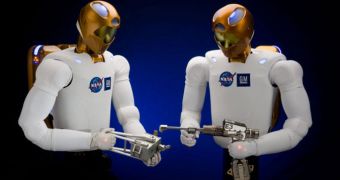Experts at the American space agency, working in collaboration with scientists from General Motors, announce the development of robonauts, robotic helpers perfectly suited for the precise labor required from astronauts working in orbit. The new instruments could be suited for a wide variety of tasks, that could see them being employed next to human workers, in solving difficult and delicate tasks in orbit, such as repairing telescopes, or making improvements on the International Space Station (ISS). The machines were designed specifically so that they can carry out tasks that require dexterity and strength, Space reports.
The Robonaut 2 is the new and improved version of the first generation of space robots developed by NASA and the US Defense Advanced Research Project Agency (DARPA) more than a decade ago. But the newest version is a lot stronger, more precise, and significantly more dexterous than the previous model. Speaking about the striking resemblance between the names of the new R2 robot, and that of R2D2, the droid of Star Wars fame, the NASA Robonaut project manager, Ron Diftler, said it is “a similarity we've noticed”. He reveals that engineers from Houston, Texas-based Oceaneering Space Systems were also involved in the work.
One of the things that really stands out about the new machines is the fact that they have thumbs featuring four joints rather than the usual three, which means that they can perform highly-precise, much more so than their makers ever could. “The thumb is obviously important, helping make us the dominant species on the planet. [The robotic thum] has roughly the order of flexibility of an astronaut in a spacesuit glove,” the NASA scientist says. In addition, it can also lift weights in excess of 20 pounds, or roughly ten kilograms, which is considerably more than any other comparable robot can boast. And it does all that while moving at a speed of 4.5 miles per hour.
“We put in more force sensors both on a joint and arm level, so if it comes into contact with astronauts unexpectedly, it can stop or completely shut down, depending on the force level it sees,” Diftler says. He adds that this was done in order to make the robot safe for interactions with humans. The machine was also covered in layers of soft fabric, whose sole purpose is to cushion it against impacts, and to prevent it from ripping spacesuits apart upon contact. Some of the main missions that R2 will need to be able to execute include changing thermal blankets on space objects, and also carrying tools around. At this point, these tasks are very cumbersome to astronauts, and they take up a lot of time.

 14 DAY TRIAL //
14 DAY TRIAL //